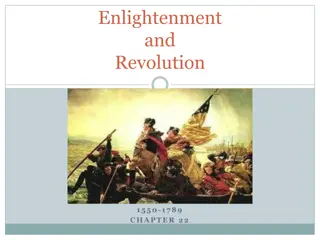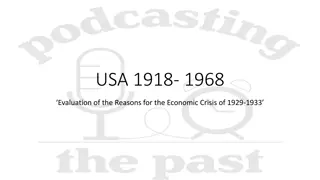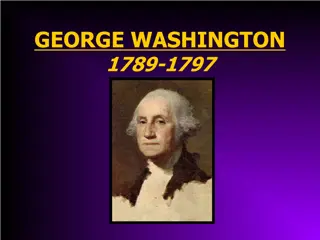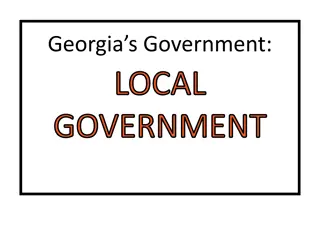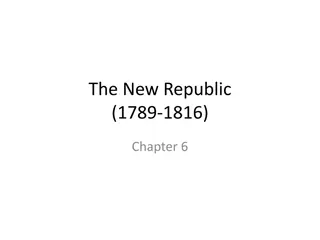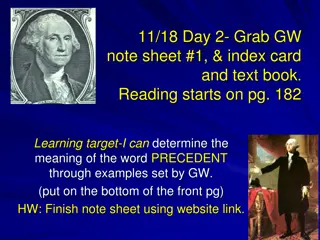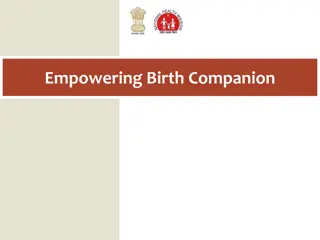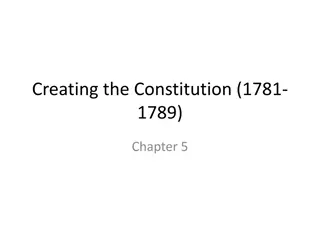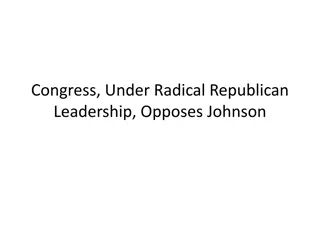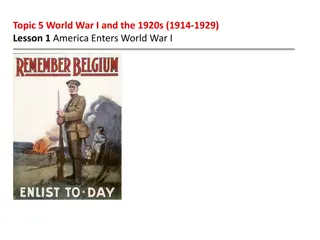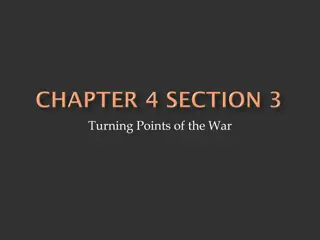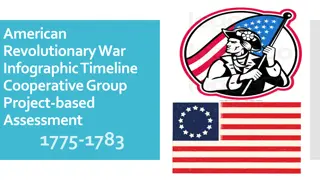Revolutionary War and the Birth of Republican Governments in America, 1776-1789
The content discusses key events and figures during the Revolutionary War era, including the challenges faced by Patriots, victories at Saratoga, financial crisis, assistance from France, military strategies, the Treaty of Paris, and the role of women and minorities. It also touches on the influence of leaders like George Washington and the diplomatic efforts that led to US independence.
Download Presentation

Please find below an Image/Link to download the presentation.
The content on the website is provided AS IS for your information and personal use only. It may not be sold, licensed, or shared on other websites without obtaining consent from the author. Download presentation by click this link. If you encounter any issues during the download, it is possible that the publisher has removed the file from their server.
E N D
Presentation Transcript
www.Apushreview.com Making War and Republican Governments 1776 1789 Check out the description for videos that match up with the new curriculum.
War in the North: Britain s military vastly outnumbered the Patriots Some Natives sided with the British Victories at Saratoga: The Battle of Saratoga was a turning point The Patriots won; France provided aid to the US (financial and military) The Perils of War: Women played an important role created clothing, ran farms Some women hoped to gain more rights (Abigail Adams) Financial Crisis: State currencies were highly inflated Robert Morris (Chief Treasury) secured valuable aid from Holland and France Valley Forge: Baron von Steuben former Prussian military officer, helped train the American army
The French Alliance: France and US made an unusual alliance (Catholic monarchy) Ben Franklin played an important role in the Treaty of Alliance America and France would ensure the independence of the US War in the South: Spain fought against Britain in 1779 Britain s Southern Strategy: The South contributed fewer individuals to war effort fear of leaving slaves unattended Philipsburg Proclamation slaves that rebelled would gain protection and freedom from Great Britain 5,000 African Americans (free and slave) fought for Patriot Cause The Marquis de Lafayette instrumental in gaining French troops to America Guerrilla Warfare in the Carolinas: Battle of Saratoga (1781) last major battle of the war, Cornwallis surrenders
The Patriot Advantage: French aid Home-field advantage Leadership George Washington Diplomatic Triumph: Treaty of Paris (1783) Britain recognized US independence US gained all land east of Mississippi River US fishing rights off Newfoundland Britain could pursue debts Spain and France gained very little France becomes severely in debt
Dont forget about us John . The State Constitutions: How Much Democracy? Pennsylvania s Controversial Constitution: Unicameral legislature was created with total power (no governor) Tempering Democracy: Other states created bicameral legislatures Most states were not truly democratic only PA and VT Women Seek a Public Voice: Abigail Adams Remember the Ladies Hoped to end customs and laws that oppressed women (married women could not own property, have contracts, etc.) Only white men were full citizens in new government The War s Losers: Loyalists, Native Americans, and Slaves: Many loyalists suffered economically, others fled Native Americans were pushed further west off their lands Slaves did not gain freedom after the war
The Articles of Confederation: Created a weak central government, states had a lot of power Each state had one equal vote in the national government In order to amend the Articles, unanimous approval was required The federal government could: make treaties, borrow money, ask for tax $ Continuing Fiscal Crisis: The US was in debt, began to sell western land The Northwest Ordinance: Slavery was banned in the Northwest Territory $ from 1 out of 36 square miles that were sold would go towards education Territories could apply for statehood when they reached 60,000 people Shays Rebellion: MA state legislature increased taxes Many farms were foreclosed Former Rev. War vet, Daniel Shays led a rebellion Demonstrated the weakness of the Articles Helped many recognize the need for a new government
The Rise of a Nationalist Faction: Sectional differences slowly emerged: northerners tended to favor tariffs, southerners did not The Philadelphia Convention: 55 delegates, mostly wealthy and upper-class Thomas Jefferson and John Adams were NOT in attendance The VA and NJ Plans: VA Plan proposed a bicameral legislature where representation in Congress was to be based on population NJ Plan favored smaller states, representation would be equal for each state The Great Compromise: Combined elements of both VA and NJ plans Created bicameral legislature: lower house (Representatives) would be based on population and elected by the people, upper house (Senate) would have 2 per state and elected by state legislatures Negotiations over Slavery: 3/5 Compromise 60% of slaves would count towards population for representation in Congress, advantage for the South National Authority: Constitution is the Supreme Law of the Land Necessary and Proper (Elastic) clause increases power of Congress
The People Debate Ratification: Constitution would take effect when 9 out of 13 states ratified it Emergence of two groups: Federalists favored ratification Anti-federalists weary of ratification The Antifederalists: Feared centralized power at states expense Criticized the lack of a bill of rights Federalists Respond: The Federalist Papers (Jay, Madison, and Hamilton) 85 essays written to promote the Constitution Federalist 10 discussed factions The Constitution Ratified: Typically, people in the backcountry were Antifederalists, easterners were Federalists With the promise of the Bill of Rights, many Antifederalists ratified the Constitution
Battle of Saratoga Foreign assistance (Spain, Holland, France) Women, Natives, and African Americans did not gain rights after the Rev. War Shays Rebellion Articles of Confederation - + s and s Northwest Land Ordinance NJ and VA Plans, and the Great and 3/5 Compromises Federalists and Antifederalists
Subscribe to my channel Press the Like button Questions? Comments? Remember to subscribe ..






